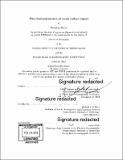| dc.contributor.advisor | Michael J. Follows. | en_US |
| dc.contributor.author | Barry, Brendan(Brendan Cael) | en_US |
| dc.contributor.other | Joint Program in Physical Oceanography. | en_US |
| dc.contributor.other | Massachusetts Institute of Technology. Department of Earth, Atmospheric, and Planetary Sciences. | en_US |
| dc.contributor.other | Woods Hole Oceanographic Institution. | en_US |
| dc.date.accessioned | 2019-09-26T19:53:41Z | |
| dc.date.available | 2019-09-26T19:53:41Z | |
| dc.date.copyright | 2019 | en_US |
| dc.date.issued | 2019 | en_US |
| dc.identifier.uri | https://hdl.handle.net/1721.1/122321 | |
| dc.description | Thesis: Ph. D., Joint Program in Physical Oceanography (Massachusetts Institute of Technology, Department of Earth, Atmospheric, and Planetary Sciences; and the Woods Hole Oceanographic Institution), 2019 | en_US |
| dc.description | Cataloged from PDF version of thesis. | en_US |
| dc.description | Includes bibliographical references (pages 137-153). | en_US |
| dc.description.abstract | Each year, surface ocean ecosystems export sinking particles containing gigatons of carbon into the ocean's interior. This particle flux connects the entire ocean microbiome and constitutes a fundamental aspect of marine microbial ecology and biogeochemical cycles. Particle flux is also variable and intricately complex, impeding its mechanistic or quantitative description. In this thesis we pair compilations of available data with novel mathematical models to explore the relationships between particle flux and other key variables - temperature, net primary production, and depth. Particular use is made of (probability) distributional descriptions of quantities that are known to vary appreciably. First, using established thermodynamic dependencies for primary production and respiration, a simple mechanistic model is developed relating export efficiency (i.e. the fraction of primary production that is exported out of the surface ocean via particle flux) to temperature. | en_US |
| dc.description.abstract | The model accounts for the observed variability in export efficiency due to temperature without idealizing out the remaining variability that evinces particle flux's complexity. This model is then used to estimate the metabolically-driven change in average export efficiency over the era of long-term global sea surface temperature records, and it is shown that the underlying mechanism may help explain glacial-interglacial atmospheric carbon dioxide drawdown. The relationship between particle flux and net primary production is then explored. Given that these are inextricable but highly variable and measured on different effective scales, it is hypothesized that a quantitative relationship emerges between collections of the two measurements - i.e. that they can be related not measurement-by-measurement but rather via their probability distributions. | en_US |
| dc.description.abstract | It is shown that on large spatial or temporal scales both are consistent with lognormal distributions, as expected if each is considered as the collective result of many subprocesses. A relationship is then derived between the log-moments of their distributions and agreement is found between independent estimates of this relationship, suggesting that upper ocean particle flux is predictable from net primary production on large spatiotemporal scales. Finally, the attenuation of particle flux with depth is explored. It is shown that while several particle flux-versus-depth models capture observations equivalently, these carry very different implications mechanistically and for magnitudes of export out of the surface ocean. A model is then proposed for this relationship that accounts for measurements of both the flux profile and of the settling velocity distribution of particulate matter, and is thus more consistent with and constrained by empirical knowledge. | en_US |
| dc.description.abstract | Possible future applications of these models are discussed, as well as how they could be tested and/or constrained observationally. | en_US |
| dc.description.statementofresponsibility | by Brendan Barry. | en_US |
| dc.format.extent | 153 pages | en_US |
| dc.language.iso | eng | en_US |
| dc.publisher | Massachusetts Institute of Technology | en_US |
| dc.rights | MIT theses are protected by copyright. They may be viewed, downloaded, or printed from this source but further reproduction or distribution in any format is prohibited without written permission. | en_US |
| dc.rights.uri | http://dspace.mit.edu/handle/1721.1/7582 | en_US |
| dc.subject | Joint Program in Physical Oceanography. | en_US |
| dc.subject | Earth, Atmospheric, and Planetary Sciences. | en_US |
| dc.subject | Woods Hole Oceanographic Institution. | en_US |
| dc.subject.lcsh | Signal processing. | en_US |
| dc.subject.lcsh | Reynolds stress. | en_US |
| dc.subject.lcsh | Ocean currents. | en_US |
| dc.subject.lcsh | Oceanographic instruments. | en_US |
| dc.title | Distributional models of ocean carbon export | en_US |
| dc.type | Thesis | en_US |
| dc.description.degree | Ph. D. | en_US |
| dc.contributor.department | Joint Program in Physical Oceanography | en_US |
| dc.contributor.department | Massachusetts Institute of Technology. Department of Earth, Atmospheric, and Planetary Sciences | en_US |
| dc.contributor.department | Woods Hole Oceanographic Institution | en_US |
| dc.identifier.oclc | 1102054351 | en_US |
| dc.description.collection | Ph.D. Joint Program in Physical Oceanography (Massachusetts Institute of Technology, Department of Earth, Atmospheric, and Planetary Sciences; and the Woods Hole Oceanographic Institution) | en_US |
| dspace.imported | 2019-09-26T19:53:41Z | en_US |
| mit.thesis.degree | Doctoral | en_US |
| mit.thesis.department | EAPS | en_US |
